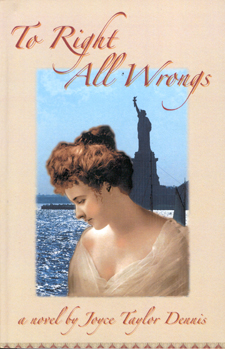|

To Right All Wrongs
Joyce Taylor Dennis
Review by Marta Palos
A combination of family saga, murder mystery and romance, To Right
All Wrongs unfolds in New York City around the '40s, when immigrants
were often exploited by organized crime.
In 1918, young Laureen O' Brian leaves Ireland for America with a man
of Polish origin. She marries Sandowski on the ship, implausibly unaware
of his brutish nature. Her dreams of a better and more exciting life
than the one she has left behind are shattered when they land in New
York and plunge into poverty and despair. Referrals to the hardship
the Sandowskis had to endure are plenty, but the grim details to make
their poverty palpable are few. Giving birth to six boys and a girl,
Laureen becomes the epitome of the saintly wife, suffering for decades
without complaints on the side of an alcoholic husband. Through the
friendship of their daughter Janice and Esther Mason, the daughter of
wealthy parents, an idyllic relationship is established between the
two families. Peace is disrupted by the murder of Esther, the tragedy
brought on by her good-for-nothing brother who steals money from the
Mob. Janice is devastated by the loss of her friend. Enters Brenton
Cross, a tall, handsome detective from the New York police force. Janice
and Brenton fall in love, and the detective becomes the transforming
power that will eventually right all wrongs the Sandowskis had to suffer.
After many twists and turns laden with dead bodies, happiness abounds
at last. Sandowski's death relieves Laureen from her sufferings, and
when she discovers a sizable insurance money left to her by her husband,
she forgives all his sins and decides to use the money for a trip back
to Ireland. Thanks to Brenton Cross, her sons pestered by the Mob find
peace and contentment, and Janice weds the dashing detective in a bliss
we're assured will last forever. After the wedding the three of them
sail together for Ireland. The newlyweds eventually return to America,
and Laureen finds love and happiness in her home country.
The majority of characters are either very good or very bad. The background
of every character is reported in minute detail, and the author enters
the mind of everyone, even that of a butler. Exposition is often redundant,
the scenes are too long-winded, countless adverbs pepper the narrative.
To lend authenticity to Laureen's Irish dialect, her speech is occasionally
spelled in a cumbersome way--simply saying that she had an Irish accent
would have done the job. The best-written parts are the ones dealing
with the investigation of the murder. When it comes to love and romance,
the author falls prey to flowery prose: "…their lips met in
a dance of passion…", to quote just one example. Surprisingly,
here and there the pathos is forgotten, and the hero's loving exclamations
addressed to his bride sound more like coming from a hick than from
the intelligent man we're told he is.
I closed the book with the sense of having read a fairy tale written
for the starry-eyed readers of Harlequin novels. However, the author
has organized her material well, and her sense of story is indisputable.
Her skills could be honed further if she would part with the mold of
romance novels and create her own style and true-to-life, three-dimensional
characters.
Great Reading Books, 2005: ISBN 978-1-933538-07-5
|